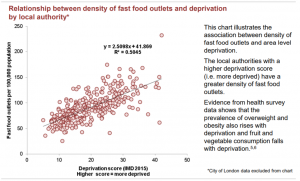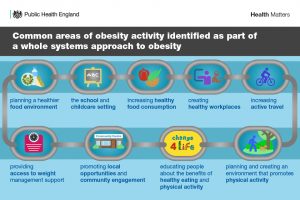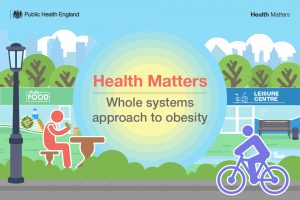Health Matters: Addressing the food environment as part of a local whole systems approach to obesity
The wider determinants of health
Obesity is a complex public health challenge driven by a mixture of the social, economic, biological and environmental factors that shape our lives and individual behaviours. These drivers have become woven into the fabric of how we live our lives, and systemic change is needed. However, action is also importantly required on the wider determinants of health, which include a range of influences from our education to employment and income, the quality and safety of the built and natural environment, and the places we live and work in.
It is clear that creating a healthier living environment and addressing the wider determinants of health will help improve health equity, as well as overall health.
The food and drink environment and obesity
In England, most people spend large amounts of their time in built environments, like towns and cities. The food available, neighbourhood design, housing, transport and access to health care and schools are all recognised as key features in promoting health, yet not everyone has equal access to health promoting options.
Many people find it challenging to eat healthily, primarily because we are living in less than healthy environments, where less healthier food options are the default, making it harder to maintain healthier lifestyles. Meals eaten outside of the home tend to be associated with higher intakes of sugar, fat and salt, and portion sizes tend to be bigger. The increasing consumption of out-of-home meals has been identified as an important factor contributing to rising levels of obesity.

Evidently, the food environment is important to us and it should help drive our health, not work against it. As such, improving the nutrient content of the food and drink we buy, cook and eat is a priority – at both a national and local community level. Addressing health inequalities demands that organisations work together to create healthier food environments for everyone, particularly when it appears that some of our most deprived areas have 5 times more fast food outlets compared to the most affluent areas.

To support specific action on health inequalities, PHE, with the Local Government Association and the Association of Directors of Public Health, published Place Based Approaches to Reducing Health Inequalities. This provides guidance and resources for local areas on how they can work together at the civic, service and community level to reduce inequalities.
Local authorities are addressing the food environment
Influencing the food environment to ensure that more and healthier options are available, accessible and affordable can only be accomplished through a collaborative approach. This requires effective partnerships and coordinated action at both a national and local level across the public, private and voluntary sectors.
The latest edition of Health Matters focuses on a whole systems approach to obesity. This is a ‘Health in All Policies’ approach that draws on local authorities’ strengths, supports their leading priorities, and recognises that they can create their local approaches more effectively by engaging with their community and local assets.

Local authorities are in a uniquely influential position to lead their communities and local partners to help improve the food environment and reduce inequalities. At the same time, there is potential to diversify the retail offer and help support a more vibrant high street.
Many local authorities across England have already taken action, with at least 40 areas having developed policies to restrict the proliferation of excess takeaways and fast food outlets on the high streets and around schools. PHE has helped develop planning guidance to support other areas in doing this.
Furthermore, to help tackle childhood obesity, some areas have developed ‘healthier zones’ and ‘School Superzones’ are being tested in 13 boroughs across London. Actions include limiting the number of fast food outlets and advertising of unhealthy foods in areas that already have a high concentration of these outlets, high levels of deprivation, or where children gather.
The Childhood Obesity Trailblazer Programme is further supporting local authorities to take action, as it asks councils to lead innovative action in their local community to tackle childhood obesity. Five council led projects have now been selected as Trailblazer Authorities, and 3 of these in particular are focusing on creating a healthier food environment through the planning system and engagement with local communities. This is set out in the Prevention Green Paper.
This local level work complements the work being done at a national level, such as PHE’s calorie, sugar and salt reformulation programmes.
Using resources that promote a healthier food environment
It is important that each local authority understands the local drivers of obesity and hence opportunities, so that their approaches are tailored to reflect the scale of the problem. This also involves identifying local aspects that may act as barriers to promoting a healthy weight, such as planning policies that may be inadvertently allowing a build-up of fast food outlets in an area or the food offer of local businesses.
This previous edition of Health Matters focuses on obesity and the food environment, setting out calls to action for local authorities, small food businesses, schools, town planners and health professionals. It looks at PHE’s strategies for encouraging healthier ‘out of home’ food provision toolkit, which can help local councils to think about how – through working in a systems approach – they might bring together a coalition of partners to improve the food environment.
The Healthier catering guidance for different types of businesses accompanies the toolkit, providing tips for businesses on how to provide and promote healthier food and drink for adults, children and families.
Furthermore, the Planning healthy-weight environments resource, co-created by PHE and the Town and Country Planning Association, can help to create a common understanding of what elements to focus on in order to bring about a healthy-weight environment. The resource also sets out the range of opportunities that exist to influence the planning process and planning policy-making in the interests of reducing obesity.
By improving how people can access every day food, we can help healthier food become the default choice, improve the quality of life for future generations, and reduce health inequalities driven by the food environment. Addressing this is an important part of taking a whole systems approach to tackling obesity.
Visit the Health Matters area of GOV.UK or sign up to receive the latest updates through our e-bulletin. If you found this blog helpful, you can read other Health Matters blogs.
You may also be interested in the following blogs:
Health Matters: Whole systems approach to obesity
Heath Matters: Obesity and the food environment
Putting healthier food environments at the heart of planning
Creating healthier spaces for London’s children to live, learn and play
View original article
Contributor: Jamie Blackshaw

